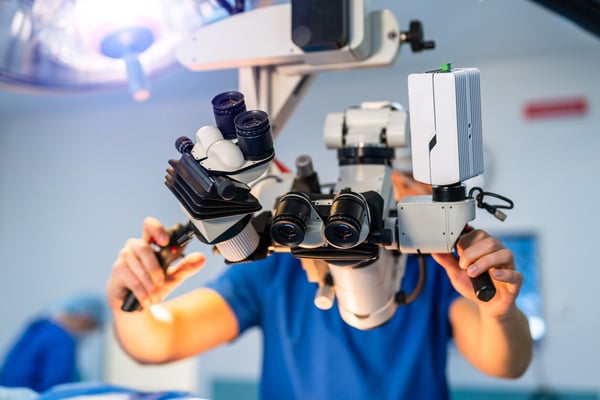Reconstructive Procedures: Reconstructive Microsurgery
Reconstructive Microsurgery
What is reconstructive microsurgery?
The cornerstone of reconstructive microsurgery is flap surgery. A flap is tissue with its own blood supply that is taken from one part of your body to replace missing tissue in another part. Almost any type of tissue can be taken as a flap, including skin, fat, muscle, bone, and nerve, either in isolation, or in combination as a chimera flap. When a flap is used without having to cut off its blood supply, it is referred to as a locoregional or pedicled flap. When the flap has its blood supply first cut off at the donor site and subsequently restored at the defect site, this is known as free tissue transfer or free flap surgery. With modern microsurgical techniques, free flap success rates remain consistent at 97 to 98%.
More recently, reconstructive microsurgery has given rise to the fields of perforator flap and supramicrosurgery. In the former, small perforating vessels to the skin are isolated and the tissue transferred to the defect site with minimal donor site morbidity. In the latter, vessels and lymphatics that measure 0.8mm or less in diameter are sutured together under a microscope to restore tissue viability and function, and is most noticeably used in surgery to treat lymphedema.
Am I a candidate?
How is it performed?
Reconstructive surgery is commonly performed under regional or general anaesthesia, especially for larger defects. You will commonly be asked to fast for at least 6 to 8 hours before the procedure. Sips of water on the morning of the procedure are usually permitted.
During the procedure, the defect that requires reconstruction will be defined (recipient site). This is either from a pre-existing defect or created by resection which is usually done in the same sitting. As much as possible, your plastic surgeon will try to raise the flap to be used (donor site) for the reconstructive procedure concurrent with any resection that needs to be done to minimize anaesthesia time. Once ready, the flap will be brought into the recipient site and the donor site is closed. If a free flap procedure or nerve restoration is required, the operating microscope will be used to visualize these structures and delicately suture them together to restore continuity. Closure of the recipient site will then be completed. Quite often, drains will be placed to remove any excess blood or fluid, or monitor for post-operative bleeding or infection.

Post-operative care, risks and complications
Why choose Polaris Plastic Surgery?
Schedule a consultation with one of our doctors to assess your needs and goals. They will communicate with you regarding your concerns, and in discussion formulate and perform the appropriate reconstructive procedure to optimize your functional and aesthetic outcomes.
PATIENT STORIES
Post Massive Weight Loss Body Contouring
A 40-year-old lady consulted with Dr Pek with the desire to correct large amounts of excess skin and soft tissue. She had undergone Bariatric Surgery (Sleeve Gastrectomy) 2 years prior to her presentation and had successfully lost almost 30kg of weight. With ... Read more
Treat Gynecomastia with Minimally Invasive Methods in Singapore
A 38-year-old male engineer presented to Dr Pek with symptomatic growth of his chest/breast area. Since puberty, he complained of unusually prominent chest tissue around his nipple and areolar region. This had worsened gradually over the years, with the left ... Read more
Upper eyelid lift and eyebags rejuvenation
63 years old Chinese female with hypertension and hyperlipidemia presented to Dr Pek with significant droopiness of her upper eyelids on both sides, affecting the upper portion of her visual field. She would constantly feel that her upper eyelids were heavy, ... Read more
Bilateral breast reconstruction using abdominal free flaps
A 45-year-old mother of 2 children was diagnosed with left breast cancer, for which a skin-sparing mastectomy (total removal of breast tissue leaving behind the skin envelope) was recommended. Read more
ARTICLES
TL;DR: A tummy tuck (abdominoplasty) goes beyond aesthetics ...
TL;DR: Lymphedema is long-term swelling caused by poor ...
Contact Form
1 Orchard Boulevard #10-08 Camden Medical Centre, Singapore 248649
6 Napier Rd, #08-01 Gleneagles Medical Center, Singapore 258499
Tel: +65 6737 4565 | Mobile: +65 8828 4565 | Email: clinic@polarisplasticsurgery.com | Business Hours: Mon - Fri: 9am - 6pm | Sat: 9am - 1pm | Sun/Ph: Closed












